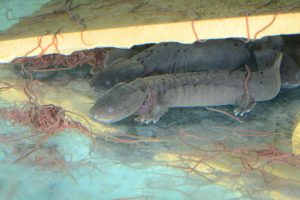
Biologists with the Indiana Department of Natural Resources (DNR) and Purdue University recently documented a very young hellbender salamander, a gilled larva, in the Blue River while conducting routine surveys in south-central Indiana. This discovery is significant because over the past three to four decades, only adult hellbenders have been documented in the Blue River. The presence of a young salamander suggests that conservation efforts and rearing programs are accomplishing their goals for the recovery of this endangered species.
The hellbender (Cryptobranchus alleganiensis) is a large, fully aquatic salamander. Hellbenders do not reach sexual maturity until they are 7-8 years old and require specific habitats to thrive and reproduce. Their decline statewide has been documented as far back as the early-to-mid 1900s as a result of habitat loss and poor water quality. Hellbenders play an important role in aquatic ecosystems and are indicators of clean water.
“Finding hellbender larvae is a huge benchmark of the program’s success,” said DNR’s Nate Engbrecht, the state herpetologist. “It tells us that there has been successful breeding, hatching, and recruitment in the wild. It’s a wonderful sign that captive-reared and released hellbenders are doing what we want them to do at this site.”
The Indiana Hellbender Partnership is a collaboration between the Indiana DNR and Purdue University with funding support from the Indiana DNR Nongame Wildlife Fund, U.S. Fish & Wildlife Service, and partners in local governments, universities, non-governmental organizations, and zoos that are working to recover the state-endangered hellbender. Developed over 15 years, the Indiana Hellbender Partnership is the largest and most comprehensive group working to recover an imperiled amphibian in Indiana.
Since 2017, Purdue University’s Help the Hellbender Lab and its conservation partners have reared and released nearly 500 juvenile hellbenders into the Blue River. Lab director Rod Williams says, “This finding, the result of nearly two decades of collective effort, signifies a milestone for our conservation program. While we have much left to do, we have evidence our approach is working.”
In the event anglers accidentally hook a hellbender, they are reminded to cut the line and let the salamander go unharmed.
